|
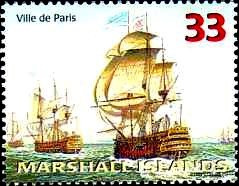
|
Maritime Topics On Stamps :
Ships of the Line!
| |
sailing in keel line.......
|
The term 'line ships' or 'ships of the line' was subject to a lot of changes throughout
history. Today general cargo ships and passenger liners, sailing on fixed routes
according to fixed schedules, are called line ships. However at the end of the 19th,
beginning of 20th century only the large armoured battle ships were known as line ships.
In the 17th and 18th century the great battle ships, which were sailing in line
formation into a battle, were called ships of the line. This Theme is about the latter.
| |
In April 1653 two new significant orders for the British Fleet came into effect.
The first one was a set of instructions for better command of the fleet on high seas.
They consisted of sailing instructions and standards for communication. The second one
referenced command during a battle. For the very first time a included the order to form
a keel line, i.e. every ship had to follow the forward ship with a distance of one
cable (185m). In addition several manoeuvres were listed to keep in the line. The line
was divided into a front group, a center group containing the largest battle ships of
the fleet and a rearguard.
|
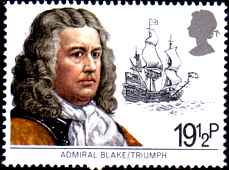
|
This fleet tactic stayed in use until the beginning of the 19th century. On the stamp
you can see Admiral Blake, leader of the British Fleet in those days and the one who
signed the new order documents.
The French fought with the same tactics. The 'Tactique Navale' of 1763 rejected
short-distance fighting and the habit of entering enemy ships. The captains were ordered
to hold their battle position in a straight line.
|
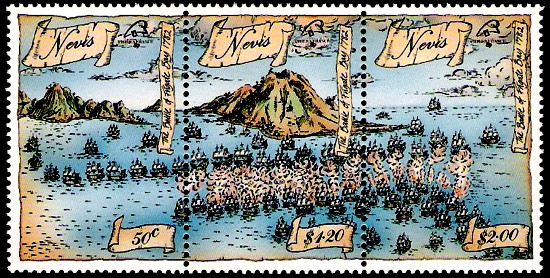
|
On these stamps of the battle off the coast of the Caribic island of St.Kitts you can
see the ships in a line formation. In January 1782 the French Comte de Grasse arrrived
with 24 ships of the line at the island of St. Kitts and disembarked 8,000 soldiers at
Basseterre. The British Rear Admiral Hood was able to form a line with his 22 ships just
in front of the harbour. When the French attacked, they sailed into the full broadsides
of the British Ships. The French had to stop the attack, while Hood's fleet anchored.
On the next day the French conducted a second attack, but were repulsed again.
|
|
On the ships of the line the guns were placed in two to four different battery decks.
The ships were called twodecker, threedecker or fourdecker according to the count of
battery decks. The heaviest guns were always placed on the lowest battery deck; there
stood the 32- pound guns. The 24- and 12-pound guns were placed in the tween deck and
the upper deck. All guns were muzzle-loaders and had to be operated by several persons.
The small guns were handled by six men, the middled-sized by 10 and the large guns by 12
to 14 persons. After firing they needed 20 to 30 minutes for loading and shooting again.
A ship of the line with 100 guns was able to fire half a ton of ammunition at an enemy
ship with one broadside. The heaviest guns had a range of up to 1.5 km.
|
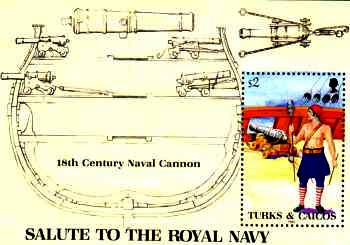
|
The ships of the Royal Navy were divided into six groups according to their figthing
strength. The groups were called rate-1 to rate-6. Ships of the line had a rate of one
to three, rate four to six consisted of smaller units.
Rate-1 ships carried a crew of 850 to 1,000 men, 100 or more guns on three or four decks
and a displacement of 2,000 tons or higher.
|
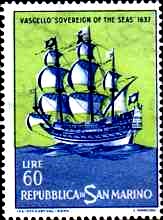
|
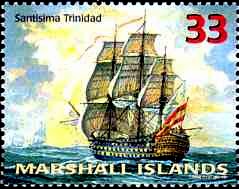
|
Here you can see two rate-1 ships. To the left the 'Sovereign of the Seas'. She was
built in 1637 and the largest, most expensive, most decorated and most heavily armed
ship of those days. She was the first threedecker and her speed was 7kn. Her specs:
167ft x 48ft x 29ft, 100 guns. In 1649 she was renamed to 'Sovereign'. In 1660 a redesign
converted her into a twodecker. This increased her battle strength and she was renamed
to 'Royal Sovereign'. Throught the years this ship fought in seven battles. In 1669 she
was lost to fire. A lit candle fell into the cargo room and inflamed the ship.
To the right you can see the Spanish 'Santissima Trinidad'. She was build in 1769,
her measurement were 164ft x 53ft x 23ft and she was equipped with 130 guns. The
'Santissima Trinidad' was the one and only fourdecker ever built and had a crew of 1,000
men, although she was slow and difficult to sail. In 1805 she was attacked and finally
captured by the Britons during the battle of Trafalgar. The following storm sank the
heavily damaged ship.
|
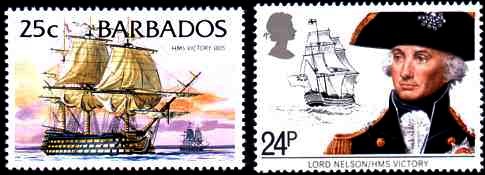
|
|
The 'Victory' of admiral Nelson was a rate-1 ship, too. She was built as a threedecker
and entered service in 1778. Her specs: 226ft x 52ft x 22ft, 102 guns, 850 crew members,
3,500 tons, 36 sails at three fir-wood-masts. In strong winds she was able to go 10
knots, but average sailing speed was around 6kn. Her hull was built with up to 2ft thick
English oak planks. She was a floating fortress, armed with 35 tons gun powder and 120
tons ammunition. The 'Vicory' was the flag- ship of the admirals Kampenfelt, Howe, Hood,
Jervis and Nelson. She fought succesfull in six sea battles. In the battle of Trafalgar
she lost one mast and had to be towed to Gibraltar. In 1922 the 'Victory' was towed to
Portsmouth and serves as a museum ship up to today.
|
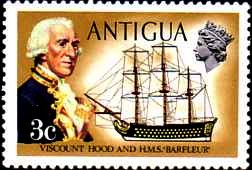
|
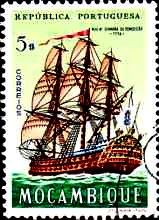
|
Rate-2 ships carried 750 to 850 crew members, 84 to 98 guns on three decks and a
displacement of 1,650 to 1,950 tons. To the left you can see the 'Barfleur'. She was
built in 1768, displacement 1,947 tons, 108 guns on three decks. Because of the large
proportion of small guns she was classified only as a rate-2 ship. She took part in
seven battles, including St. Kitts, the Chesapeake Bay and the Saints. In 1819 she was
wrecked.
To the right you can see a stamp with the Portuguese 'Nossa Senhora de Conceicao'. She
was built in 1716 with a crew of 700. Her greatest success happened during the battle at
Cape Matapan, Greece. There the 'Senhora' single-handedly wrecked the flag-ship of the
Turkish fleet und decided the battle.
|
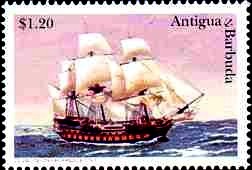
|
Rate-3 ships carried 520 to 750 crew members, 64 to 80 guns on three decks and a
displacement of 1,200 to 1,600 tons. To the left you can see the French 'Le Protecteur'.
She was built in 1761, her measurements were 184ft x 36ft x 19ft. The 'Le Protecteur' had
64 guns and 678 crew members aboard. Under the command of Admiral De Grasse she fought
in the battle of Dominica.
|
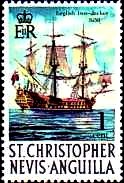
|
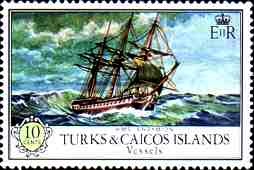
|
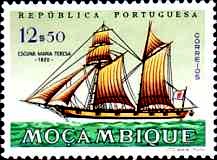
|
The rate-4 to rate-6 ships didn't belong to the category 'ships of the line'. However
for completeness reasons here are the specifications: The rate-4 ships had ca. 350 crew
members, 50 to 56 guns on two decks and a length round about 148ft. The left stamp shows
such a twodecker.
The rate-5 ships carried ca. 250 crew members, up to 50 guns and a length from 128ft to
148ft. They consisted mostly of frigates. The stamp in the middle shows the British
'Endymion'. She was built in 1779. With 44 guns she was a rate-5 ship.
The rate-6 ships had ca. 150 crew members, 20 to 28 guns on two decks and a length round
about 115ft. They were rigged as schooners or sloops and used as escort or courier ships.
The Portuguese schooner 'Santa Maria' is depicted here for size comparison.
|
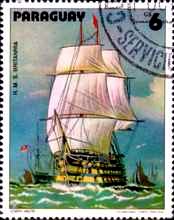
|
Back to the ships of the line. When firing a large ship-based cannon between the
lighting of the fuse and the explosion of the gun powder some seconds passed. In this
time the ship could move upwards or downwards. The result were high shots or plain or
lower shots. One say, the Britons preferred the plain shots into the hulls of their
enemies. The Dutch had lighter artillery and tried to hit masts and rig to disable the
enemy ships' manoeverability. At a distance of ca. 900ft a hit was just a lucky shot
because of the heaving ships. So some admirals used to close in to increase the chance
of hitting, i.e. reducing the distance to the enemy to 150ft or less.
| |
On the stamp you can see the rate-1 ship 'Britannia'. Built in 1820, delivered in 1824,
120 guns on three decks, 2,616 tons, length 205ft, beam 55ft. The 'Britannia' was the
flag-ship of the Royal Navy in the Mediterranean and took part in the firing of
Sewastopol during the Krim war. Since 1859 she was a training ship for the cadets and
midshipmen at Portsmouth. In 1869 she was wrecked.
| |
Frenchmen and dutchmen built ships of the line, too. The stamp at the top of this page
shows the French 'Ville de Paris'. She was delivered in 1764, carried 104 guns on three
decks and was the flag-ship of the admirals De Guichen and De Grasse. She fought in the
battles of Chesapeake Bay and the Saints. In 1782 she sank in a gale off the coast of
New Foundland.
|
|
Here you can see the French 'Soleil Royal' firing a broadside. She was the 'show-piece'
of King Louis XIV. The 'Soleil Royal' was built in 1689 as a threedecker, with 104 guns,
length 250ft, beam 51ft and carried 1,100 men aboard during war times. She served as the
flag-ship of admiral Tourville in the battle at La Hogue and was set on fire by the
Britons.
|
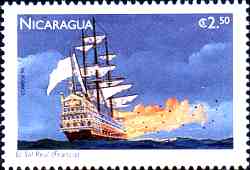
|
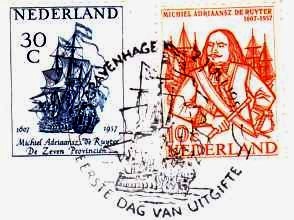 |
Here you can see the dutch admiral de Ruyter with his 'De Zeven Provincien'. Some specs:
475 crew members, 80 guns, 163ft x 43ft x 17ft. The ship took part in many sea battles
against the Britons, including the famous 'four days battle' in 1666 , which was won by
the Dutch. In 1692 the 'De Zeven Provincien' was heavily damaged at La Hogue, and finally,
in 1694, she was wrecked.
| |
In 1666, during the four days battle, both opponents, the Dutch de Ruyter and the
British Ruprecht and Albemarle tried to stick to the line formation, but without success.
In the same year the St. Jacobs sea battle saw the same opponents, but this time the
line tactics worked. This battle was won by the Britons because of the massive firepower
of their broadsides, the higher rate of fire and the superior aiming of their gunners.
|
|
During the American War of Independence the French and Americans fought against the
Britons. During this war, in 1781, the battle at Chesapeake Bay happened. The French
commander De Grasse (to the left) anchored with 14 ships of the line, when the British
admiral Graves (to the right) with his 19 ships of the line detected him. For the
British it would have been an easy job to blockade the port entrance and destroy the
French ships one by one. But the Britons stuck to their line tactics and formed a
useless line at sea.
|
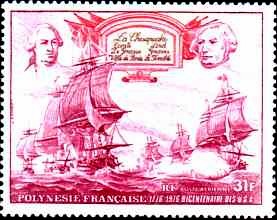
| |
So all Frenchs ship were able to leave the port trap and formed
their own line, which were going in a 'V' against the British line. So only the leading
groups were in range to fire and the British numerical superiority was gone. The French
won the battle.
|

| |
In the following year, 1782, the Britons under admiral Rodney with 36 ships of the line
and the Frenchmen under Comte de Grasse with 33 ships of the line met again. The battle
occured at the Saints, a small group of islands in the Caribic. The battle started
according to the book with both opponents sailing in a line and firing with all they had.
But then the wind direction changed and the French had problems to keep in line. Now a
historical event happened: The Britons gave up their line and broke through the French
line. They stroke their keel-line signal and left the signal for close combat.
The result was a massive victory for the British fleet. Admiral de Grasse on his heavily
damaged 'Ville de Paris' stroke the flag. On this stamp block you can see from left to
right: Magnanime (F), Aimable (F), Duke (B), Glorieux (f), Agamemnon (B), Formidable
(B);Ville de Paris (F), Namur (B), Canada (B), Albans (B), Hector (F).
|
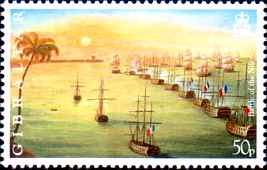
|
In 1798 Napoleon sailed his fleet to Egypt to conquer the country. While he attacked the
Egyptians ashore the fleet sailed to Aboukir and anchored in a keel line just in front of
a sandbank. The British fleet under Nelson succeeded to detect the French and immediately
attacked. 13 British ships of the line fought 13 French ships of the line. An even match,
but a change of the wind direction turned the French ships around their bow anchor,
because they had no stern anchor. This opened a gap between their fleet and the sandbank.
| |
Some British ships exploited the situation, sailed into this gap and thus were able to
catch the French in a deadly crossfire. A whole night of bloody fighting took place:
The French flag-ship 'Orient' exploded, four French ships ran ashore, another six gave
up, two fled. The Britons didn't lose a ship, but they had no ship with all masts as
well. The Battle at Aboukir is also called battle at the Nile. This stamp shows the
beginning of the battle.
|
|
In 1805 a mixed Spanish-French fleet under admiral Villeneuve and the British fleet
under admiral Nelson met at Trafalgar. It was the last great sea battle where a fleet
utilized the line formation to attack. The Britons formed two groups, which hit and broke
through the French line rectangular. The northern group was led by Nelson and his
'Victory', the southern by Collingwood with the 'Royal Sovereign'. 27 British ships of
the line fought against 18 French and 15 Spanish ships.
|
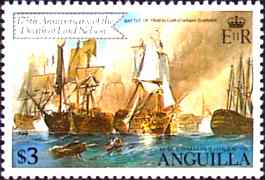
| |
More than 1,000 guns were
constantly firing, mainly at very close distance, as you can see on the stamp. Round
about 3,000 people died, among them Nelson himself. The Britons sank or captured 22
ships of the line and lost only one. With the help of the fleet Great Britain became a
world power.
|
|